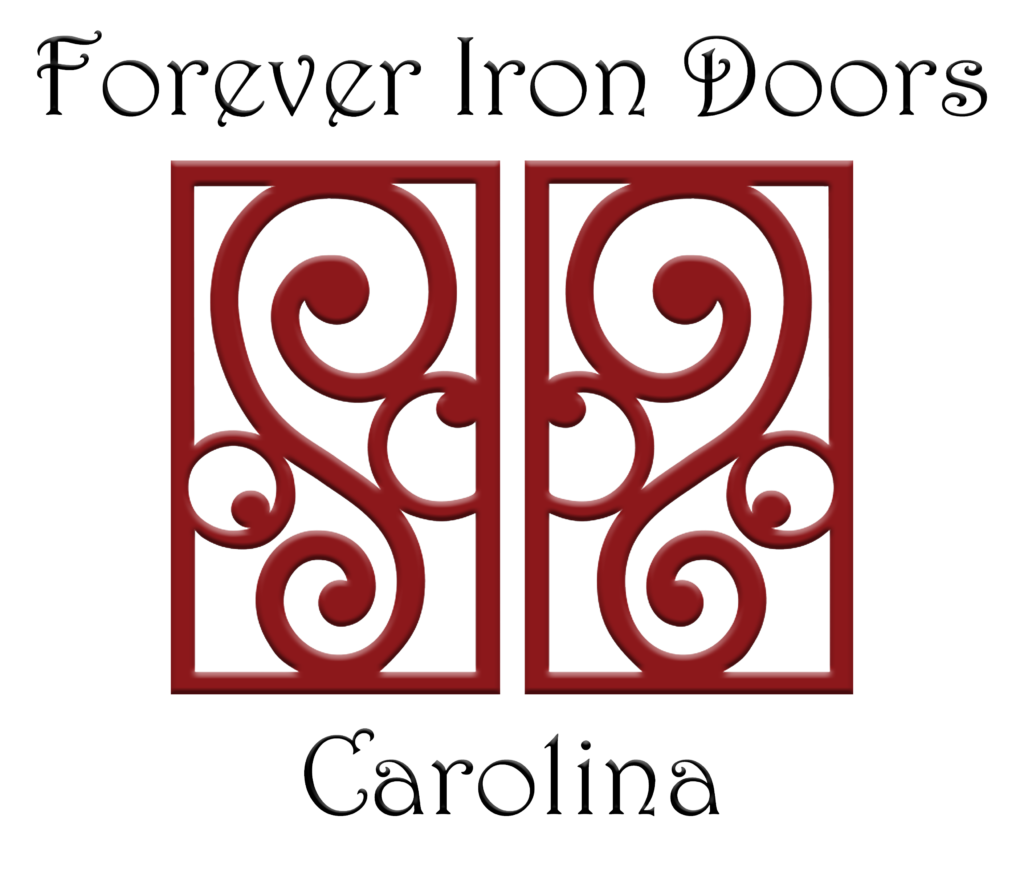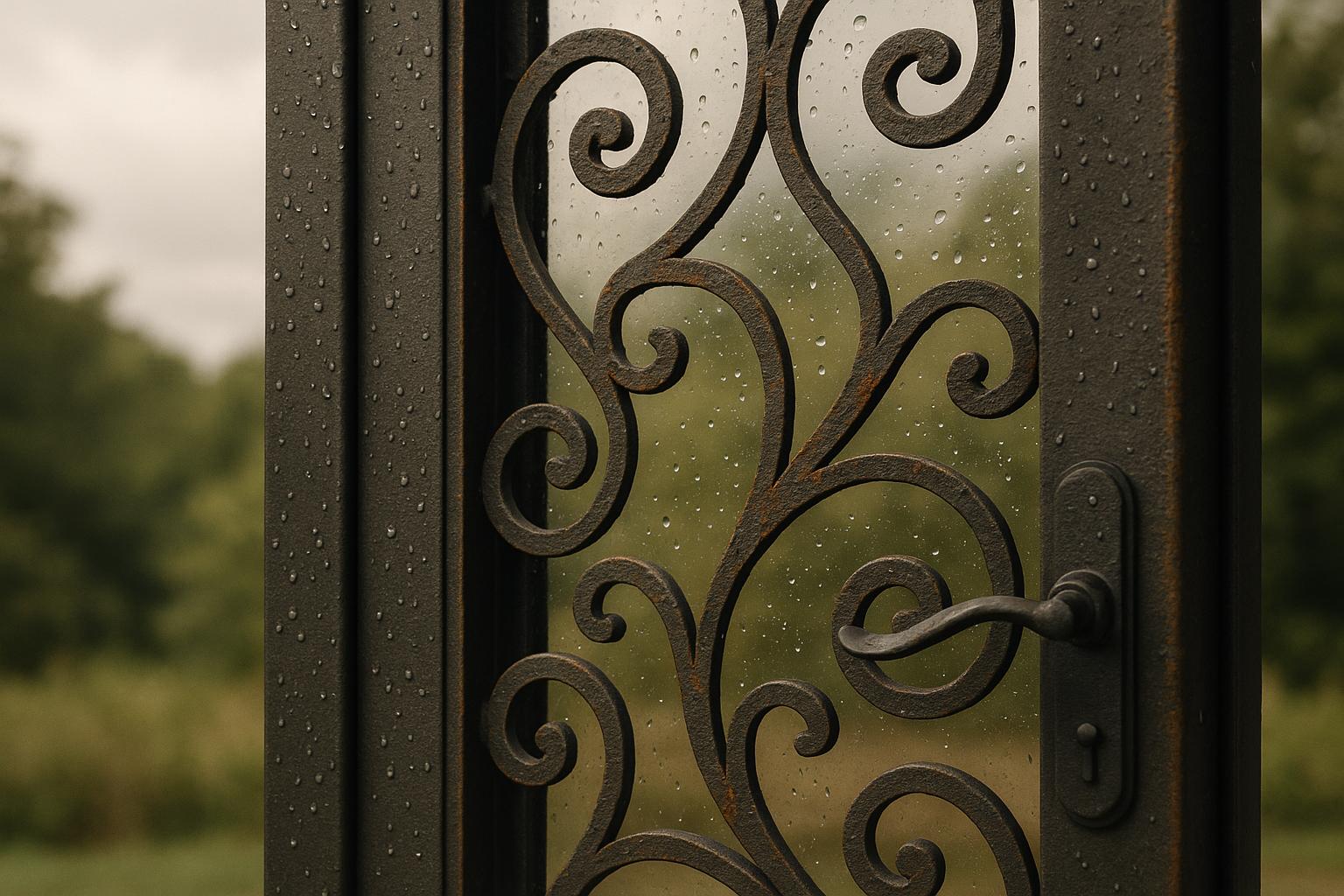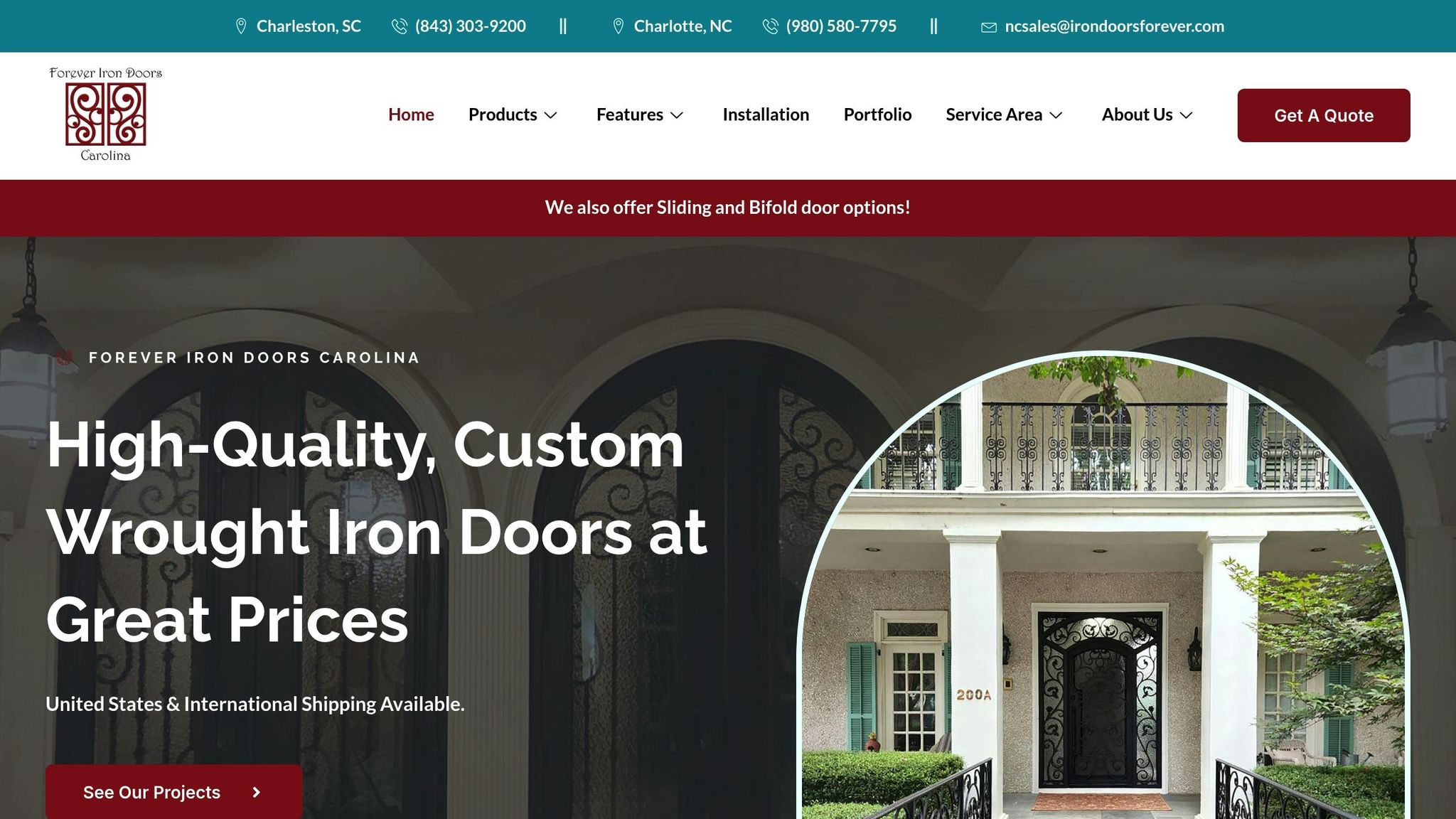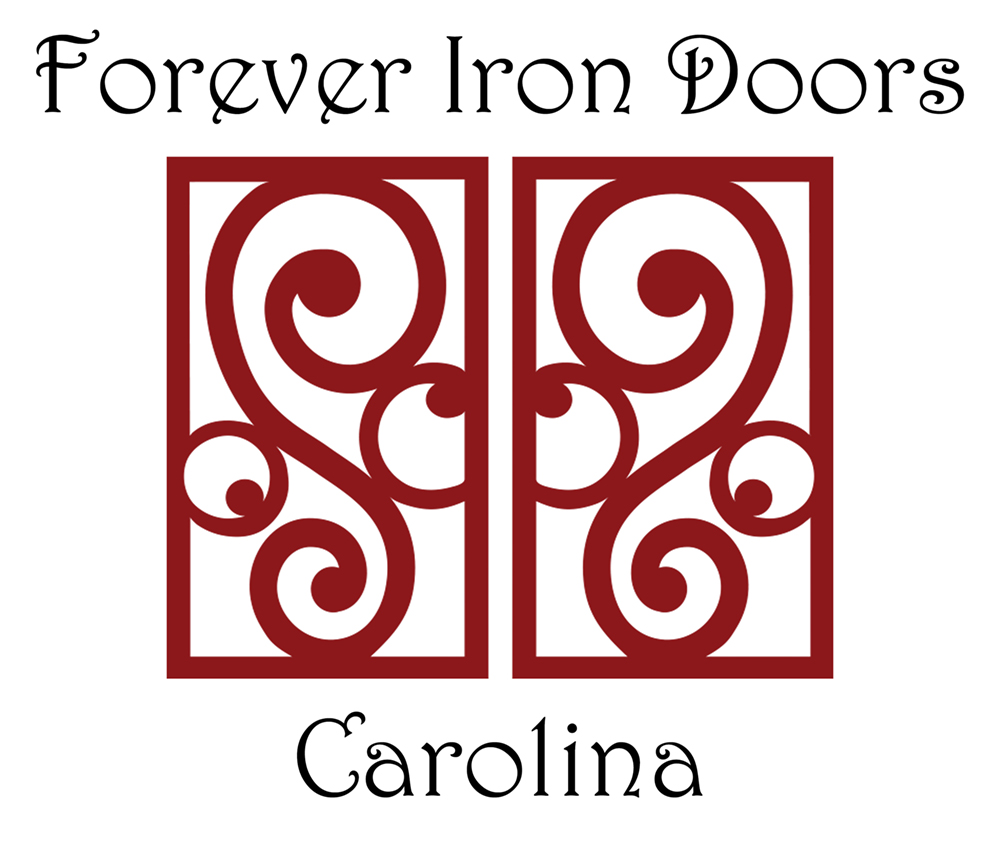Wrought iron doors are durable and stylish but highly susceptible to rust due to weather exposure. Moisture, temperature changes, and environmental factors like salt air in coastal areas accelerate corrosion, damaging both appearance and strength. Here’s what you need to know:
- Moisture: Rain, humidity, and dew trigger rust by enabling oxidation. Coastal regions face added risks from salt, which speeds up corrosion.
- Temperature Fluctuations: Expanding and contracting metal can crack protective coatings, exposing the iron beneath.
- Rust Formation: Wrought iron’s porous texture traps water, making it more prone to rust compared to smoother metals like stainless steel.
- Prevention Tips:
- Regular cleaning with mild soap and thorough drying.
- Apply rust-inhibiting primers, paints, or wax-based coatings.
- Inspect monthly for rust spots, especially in crevices and around hardware.
- Manage moisture with proper drainage, awnings, and weatherstripping.
How Rust Forms on Wrought Iron
Knowing how rust develops is key to spotting it early and preventing damage. Rust not only diminishes the look of wrought iron but also weakens its structure. The process behind its formation is driven by chemical reactions, which weather conditions can either speed up or slow down.
What Makes Wrought Iron Different?
Wrought iron stands apart from other metals due to its unique composition, which makes it more prone to rust. Unlike stainless steel, which contains chromium to create a protective layer, or aluminum, which naturally forms an oxide barrier, wrought iron lacks these protective features. This absence leaves it highly exposed to corrosion.
The metal’s rough, porous texture further adds to its vulnerability by trapping moisture, making it more susceptible to rust compared to smoother metals. While its higher carbon content offers a slight edge in protection, wrought iron – like pure iron and cast iron – still rusts when exposed to air and moisture. In fact, wrought iron tends to rust more quickly than metals like stainless steel or aluminum due to its specific makeup and surface characteristics. This combination of factors makes it particularly sensitive to harsh weather conditions.
The Rust Formation Process
Rust forms when iron reacts with oxygen and moisture. This process, known as oxidation, relies on three essential elements: iron, oxygen (from the air), and moisture (from rain, humidity, or other sources).
When iron atoms come into contact with oxygen, they form rust. Moisture and oxygen act as accelerators, driving the reaction faster, especially in damp environments.
Several factors influence how quickly rust develops, including humidity levels, oxygen availability, and the type of metal. In dry conditions, the process slows significantly, but in wet or humid environments, it picks up speed. Wrought iron’s porous surface retains water, allowing oxidation to continue even after the rain or dew has dried.
Pollutants in the air, such as sulfur dioxide, can worsen the problem. These pollutants mix with water to create acids, which further corrode the metal.
If left unchecked, rust spreads and weakens the metal’s structure. Over time, this leads to discoloration, reduced strength, and eventual deterioration. By understanding how rust forms, homeowners can identify the conditions that encourage it and take proactive measures to break the cycle before serious damage occurs.
Weather Conditions That Cause Rust
Weather plays a significant role in how well wrought iron doors hold up over time. Understanding which conditions are most likely to trigger rust can help homeowners take the right steps to protect and maintain their doors.
Humidity, Rain, and Moisture
High humidity and frequent rain are prime culprits when it comes to rust on wrought iron doors. When the air is humid, moisture tends to condense on metal surfaces, creating the perfect environment for rust to form through an electrochemical process.
Rain intensifies the problem by directly soaking the door and sneaking into small cracks and crevices in its design. This trapped moisture can keep the rusting process active even during dry periods. For example, areas like the southeastern United States face ongoing challenges with rust due to their mix of heavy rainfall and high humidity.
Coastal Climates and Salt Air
Coastal regions bring their own set of challenges for wrought iron doors. The combination of salt-laden air and moisture creates some of the harshest conditions for metal. Ocean breezes leave a layer of salt on the surface, and when mixed with moisture, this acts as an electrolyte, speeding up the rusting process.
What makes this worse is that the salt and moisture can work their way into tiny cracks or unfinished parts of the metal, causing not just surface rust but also internal corrosion. Without regular upkeep, the damage can escalate quickly.
Dale Baldwin, an industry expert, captures the difficulty of maintaining wrought iron in these environments:
"It’s a continuing problem, and so far as I know, there is nothing that will preserve a paint job on wrought iron when it has to meet the challenge of the ocean air."
The harshness of coastal climates compared to inland areas is undeniable. Coastal conditions – salt air, high humidity, and frequent rain – cause materials to break down much faster. Meanwhile, in drier climates, wrought iron tends to maintain its appearance and integrity for a longer time.
How to Prevent Rust on Wrought Iron Doors
Keeping wrought iron doors rust-free requires consistent care and attention. With the right maintenance routine, you can protect your door from corrosion and extend its lifespan.
Regular Cleaning and Maintenance
Weekly cleaning is essential to prevent rust, especially in areas where moisture tends to collect. Use warm, soapy water and a soft cloth to gently clean the surface, making sure to reach into crevices.
If you live near the coast, this step becomes even more crucial. Salt from ocean air can combine with moisture, speeding up corrosion. A simple rinse with a garden hose can help wash away salt buildup effectively.
Skip harsh chemicals like bleach or abrasive cleaners, as they can strip away protective coatings. Instead, stick to mild dish soap mixed with water. After cleaning, dry the door thoroughly to avoid water spots and lingering moisture, which can lead to rust.
Applying Protective Coatings
Protective coatings are your first line of defense against rust. High-quality primer and paint with rust inhibitors create a barrier against moisture. For areas with high humidity or salty air, marine-grade paints are a great choice as they’re designed to withstand tough conditions.
Preparation is key before applying any coating. Remove any existing rust completely using steel wool or a wire brush. Once the surface is clean and dry, you can apply the primer and paint.
For doors with intricate designs, wax-based protective coatings are an excellent addition. These penetrate into fine cracks and crevices, offering extra protection where paint might not reach.
Reapplication frequency depends on your climate. In humid or coastal areas, plan to reapply every 12 to 18 months. In drier regions, you might only need to refresh the coatings every 2 to 3 years. Regular inspections after applying coatings ensure you catch any early signs of wear or rust.
Regular Inspections and Repairs
Frequent inspections are vital to keeping rust at bay. Check your door monthly for small rust spots, particularly around hinges, locks, and decorative details.
If you notice early-stage rust – small brown or orange discolorations – address it immediately. Use fine-grit sandpaper to gently remove the rust, clean the area, and then apply primer and matching paint to seal it.
Pay close attention to the door frame and threshold, as water tends to pool in these areas, making them more prone to rust. Inspect hardware like hinges, locks, and handles as well. These moving parts often wear down protective coatings faster. After cleaning, apply a marine-grade lubricant to keep moisture out of joints and mechanisms.
Moisture Management Methods
Managing moisture is one of the most effective ways to prevent rust.
Start by ensuring proper drainage around your door. Gutters should direct water away from the foundation, and the ground should slope to prevent pooling near the door.
Awnings or overhangs can shield your door from direct rain exposure. Even a small roof extension can make a big difference during storms.
Maintain your door’s weatherstripping to keep moisture from seeping into the frame or surrounding areas. Replace any worn or damaged weatherstripping promptly to maintain a tight seal. This not only helps prevent rust but also improves energy efficiency.
If your entryway tends to trap humidity, ventilation can help. Add small vents or check that existing ventilation systems are working properly. Better airflow ensures surfaces dry quickly after rain or high humidity.
In regions with freeze-thaw cycles, keep an eye on water that might freeze in decorative elements or joints. When water freezes, it expands, potentially cracking protective coatings and creating entry points for moisture once temperatures rise.
sbb-itb-cd90297
Forever Iron Doors Carolina: Weather-Resistant Door Solutions
Forever Iron Doors Carolina knows firsthand how unpredictable the weather can be across North and South Carolina. From the salty coastal air to the freeze-thaw cycles inland, they design doors that stand up to the elements without sacrificing style. Their focus? Creating durable, weather-resistant doors that keep your home protected while looking great.
Custom Weatherproof Designs
Forever Iron Doors Carolina specializes in custom designs that offer both protection and elegance. Their glass options, for instance, are crafted to handle temperature swings and stormy conditions. Whether you’re near the coast or further inland, their durable finishes are specifically chosen to resist corrosion caused by salt air or high humidity. These protective coatings not only keep your door looking good but also ensure it holds up over time.
But it’s not just about the glass and finishes. They also offer hardware customization, with hinges, locks, and handles built to withstand moisture, temperature changes, and daily wear and tear. Every part of the door is designed to provide maximum protection against the elements, all while maintaining a stylish appearance. And with their expert design team, you’ll get a door that’s not just functional but also perfectly suited to your local weather conditions.
Professional Installation and Maintenance Support
A great door is only as effective as its installation, and that’s where Forever Iron Doors Carolina truly shines. Their professional installation team ensures your door fits perfectly, sealing out moisture and drafts with precision. They fine-tune the hardware and weatherstripping to create a tight seal, keeping the elements where they belong – outside.
For areas prone to shifting ground or settling, they also offer structural framing services to ensure your door remains properly aligned, preserving its weatherproofing over time. And they don’t stop there. Their ongoing maintenance support helps you get the most out of your investment. From cleaning tips to reapplying protective coatings, their team provides the guidance you need to keep your door looking and performing its best, even in tough weather conditions.
With Forever Iron Doors Carolina, you’re not just getting a door – you’re getting long-lasting protection and style, tailored to the unique demands of your location.
Conclusion: Protecting Your Wrought Iron Doors from Weather
Weather can take a toll on your wrought iron door, but with the right care, you can shield it from lasting damage. Exposure to various conditions often leads to rust, which can weaken the door and tarnish its appearance.
The good news? Preventing this is entirely manageable. Regular cleaning removes harmful elements, while applying protective coatings creates a barrier against moisture. Tackling rust as soon as it appears can save you from expensive repairs down the road.
These simple steps echo the expert tips shared earlier. Choosing a professionally installed, weather-resistant wrought iron door not only enhances durability but also minimizes future maintenance costs.
Forever Iron Doors Carolina is a prime example of this dedication to quality. Their custom weatherproof designs and expert installations are built to handle the challenges of Carolina’s climate. Plus, their ongoing maintenance services help protect the value of your door over time.
FAQs
How can I protect wrought iron doors from rust in humid and coastal areas?
To keep wrought iron doors in top shape in humid or coastal areas, start by applying rust-resistant coatings like powder coating, epoxy, or metal sealants. These coatings form a strong shield against moisture and salt, which are major culprits of rust. Along with that, make regular cleaning part of your routine – frequently wiping down the doors helps clear away salt and debris that can speed up corrosion. You can also use protective sprays, such as silicone or wax, to add an extra layer of defense against the elements. These straightforward measures can go a long way in preserving the appearance and durability of your wrought iron doors, even in tough conditions.
How often should I reapply protective coatings to my wrought iron door to prevent rust, especially in different weather conditions?
To keep your wrought iron door safe from rust, it’s a good idea to reapply protective coatings every 6 to 12 months if you live in humid or coastal areas. These environments can speed up corrosion due to moisture and salt exposure. In drier climates, you might only need to reapply the coating every few years. However, regular inspections are crucial no matter where you live. Watch for signs like fading or chipping, and take care of them right away to maintain your door’s durability. Routine upkeep is the key to preserving both the look and lifespan of your door.
What are the early signs of rust on wrought iron doors, and how can you prevent further damage?
Early signs of rust on wrought iron doors can show up as reddish-brown spots, paint that starts bubbling or peeling, a rough surface, or even a chalky residue. These are telltale signs that corrosion is beginning to take hold.
To tackle these issues, start by carefully removing the rust using sandpaper or a wire brush. Once the area is smooth, clean it thoroughly with soap and water to get rid of any debris. After it dries, apply a rust-inhibiting primer or a protective sealant to shield the surface. Acting quickly when you notice rust can stop it from spreading and help your wrought iron doors stay in great shape for years to come.




